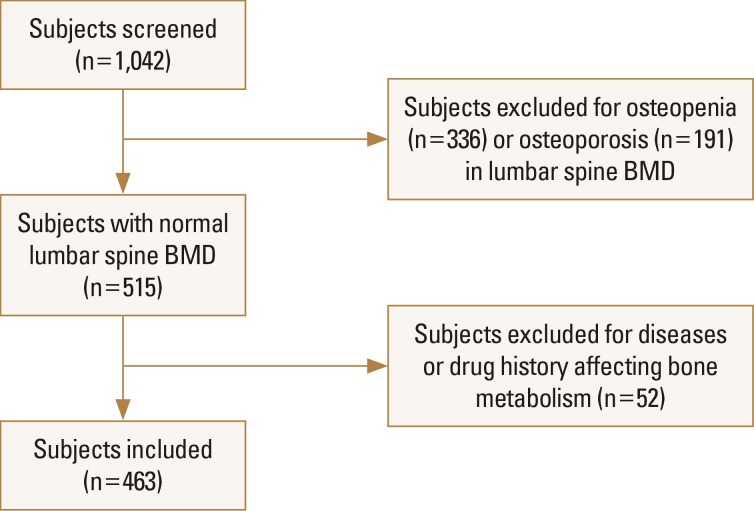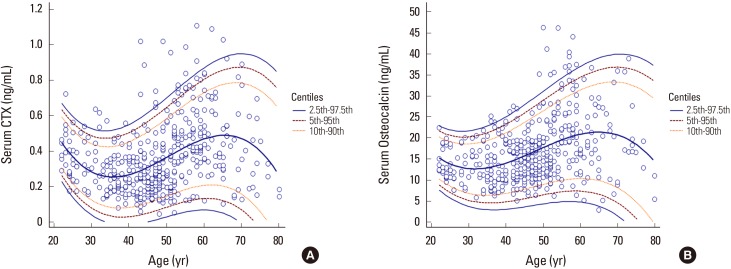J Bone Metab.
2020 Feb;27(1):43-52. 10.11005/jbm.2020.27.1.43.
Reference Intervals for Bone Turnover Markers in Korean Healthy Women
- Affiliations
-
- 1Division of Endocrinology and Metabolism, Department of Internal Medicine, Chonnam National University Hospital, Chonnam National University Medical School, Gwangju, Korea. djchung@chonnam.ac.kr
- 2Department of Health Administration, Kwangju Women's University, Gwangju, Korea.
- KMID: 2471313
- DOI: http://doi.org/10.11005/jbm.2020.27.1.43
Abstract
- BACKGROUND
Adequate suppression of bone turnover rate is important to decrease fracture risk without mineralization defect due to oversuppression. This study was performed to determine reference intervals (RIs) for 2 bone turnover markers, serum C-terminal telopeptide of type I collagen (CTX) and osteocalcin, in Korean women.
METHODS
A total of 461 Korean women (287 premenopausal and 174 postmenopausal) without any disease or drug history affecting bone metabolism was included. Serum CTX and osteocalcin were measured after overnight fasting. Bone mineral density (BMD) was measured at the 1st to 4th lumbar vertebra using dual energy X-ray absorptiometry. Subjects with normal spinal BMD (T-score ≥−1.0) were included in this study.
RESULTS
After stable concentrations were maintained, both CTX and osteocalcin were abruptly increased in 50 to 59 years, and then decreased with increasing age. Median levels and interquartile range of serum CTX and osteocalcin in all subjects were 0.322 (0.212-0.461) ng/mL and 15.68 (11.38-19.91) ng/mL. RIs for serum CTX and osteocalcin in all subjects were 0.115 to 0.861 ng/mL and 6.46 to 36.76 ng/mL. Those were higher in postmenopausal women (CTX, 0.124-1.020 ng/mL, osteocalcin, 5.42-41.57 ng/mL) than in premenopausal women (CTX, 0.101-0.632 ng/mL, osteocalcin, 6.73-24.27 ng/mL). If we use target reference levels as lower half of premenopausal 30 to 45 years in patients with antiresorptive drugs, those were 0.101 to 0.251 ng/mL and 6.40 to 13.36 ng/mL.
CONCLUSIONS
We established RIs for serum CTX and osteocalcin in healthy Korean women with normal lumbar spine BMD. Premenopausal RIs for serum CTX and osteocalcin would be useful to monitor patients with low bone mass using osteoporosis drugs.
Keyword
MeSH Terms
Figure
Cited by 1 articles
-
The Use of Bone-Turnover Markers in Asia-Pacific Populations
Samuel Vasikaran, Subashini C. Thambiah, Rui Zhen Tan, Tze Ping Loh
Ann Lab Med. 2024;44(2):126-134. doi: 10.3343/alm.2023.0214.
Reference
-
1. Garnero P, Shih WJ, Gineyts E, et al. Comparison of new biochemical markers of bone turnover in late postmenopausal osteoporotic women in response to alendronate treatment. J Clin Endocrinol Metab. 1994; 79:1693–1700. PMID: 7989477.
Article2. Delmas PD, Hardy P, Garnero P, et al. Monitoring individual response to hormone replacement therapy with bone markers. Bone. 2000; 26:553–560. PMID: 10831925.
Article3. Park SY, Ahn SH, Yoo JI, et al. Clinical application of bone turnover markers in osteoporosis in Korea. J Bone Metab. 2019; 26:19–24. PMID: 30899720.
Article4. Park SY, Ahn SH, Yoo JI, et al. Position statement on the use of bone turnover markers for osteoporosis treatment. J Bone Metab. 2019; 26:213–224. PMID: 31832387.
Article5. de Papp AE, Bone HG, Caulfield MP, et al. A cross-sectional study of bone turnover markers in healthy premenopausal women. Bone. 2007; 40:1222–1230. PMID: 17331821.
Article6. Gertz BJ, Shao P, Hanson DA, et al. Monitoring bone resorption in early postmenopausal women by an immunoassay for cross-linked collagen peptides in urine. J Bone Miner Res. 1994; 9:135–142. PMID: 8140926.
Article7. Vasikaran S, Eastell R, Bruyère O, et al. Markers of bone turnover for the prediction of fracture risk and monitoring of osteoporosis treatment: a need for international reference standards. Osteoporos Int. 2011; 22:391–420. PMID: 21184054.
Article8. Srivastava AK, Vliet EL, Lewiecki EM, et al. Clinical use of serum and urine bone markers in the management of osteoporosis. Curr Med Res Opin. 2005; 21:1015–1026. PMID: 16004668.
Article9. Johansson H, Odén A, Kanis JA, et al. A meta-analysis of reference markers of bone turnover for prediction of fracture. Calcif Tissue Int. 2014; 94:560–567. PMID: 24590144.
Article10. Glendenning P. Markers of bone turnover for the prediction of fracture risk and monitoring of osteoporosis treatment: a need for international reference standards: osteoporos int 2011;22:391-420. Clin Biochem Rev. 2011; 32:45–47. PMID: 21451777.11. Garnero P, Sornay-Rendu E, Claustrat B, et al. Biochemical markers of bone turnover, endogenous hormones and the risk of fractures in postmenopausal women: the OFELY study. J Bone Miner Res. 2000; 15:1526–1536. PMID: 10934651.
Article12. Yoon BH, Yu W. Clinical utility of biochemical marker of bone turnover: Fracture risk prediction and bone healing. J Bone Metab. 2018; 25:73–78. PMID: 29900156.
Article13. Recker R, Lappe J, Davies KM, et al. Bone remodeling increases substantially in the years after menopause and remains increased in older osteoporosis patients. J Bone Miner Res. 2004; 19:1628–1633. PMID: 15355557.
Article14. Recker R, Stakkestad JA, Chesnut CH 3rd, et al. Insufficiently dosed intravenous ibandronate injections are associated with suboptimal antifracture efficacy in postmenopausal osteoporosis. Bone. 2004; 34:890–899. PMID: 15121021.
Article15. Pi YZ, Wu XP, Liu SP, et al. Age-related changes in bone biochemical markers and their relationship with bone mineral density in normal Chinese women. J Bone Miner Metab. 2006; 24:380–385. PMID: 16937270.
Article16. Hoshino H, Kushida K, Takahashi M, et al. Changes in levels of biochemical markers and ultrasound indices of Os calcis across the menopausal transition. Osteoporos Int. 2000; 11:128–133. PMID: 10793870.
Article17. Glover SJ, Gall M, Schoenborn-Kellenberger O, et al. Establishing a reference interval for bone turnover markers in 637 healthy, young, premenopausal women from the United Kingdom, France, Belgium, and the United States. J Bone Miner Res. 2009; 24:389–397. PMID: 18665786.
Article18. Glover SJ, Garnero P, Naylor K, et al. Establishing a reference range for bone turnover markers in young, healthy women. Bone. 2008; 42:623–630. PMID: 18289953.
Article19. Adami S, Bianchi G, Brandi ML, et al. Determinants of bone turnover markers in healthy premenopausal women. Calcif Tissue Int. 2008; 82:341–347. PMID: 18470550.
Article20. Yoo JI, Park AJ, Lim YK, et al. Age-related reference intervals for total collagen-I-N-terminal propeptide in healthy Korean population. J Bone Metab. 2018; 25:235–241. PMID: 30574468.
Article21. Wu XY, Zhang H, Xie H, et al. Reference intervals of bone turnover markers determined by using their curve-fitting valley for adult females in China. Osteoporos Int. 2014; 25:943–952. PMID: 23877870.
Article22. Ardawi MS, Maimani AA, Bahksh TA, et al. Reference intervals of biochemical bone turnover markers for Saudi Arabian women: a cross-sectional study. Bone. 2010; 47:804–814. PMID: 20659600.
Article23. Gossiel F, Finigan J, Jacques R, et al. Establishing reference intervals for bone turnover markers in healthy postmenopausal women in a nonfasting state. Bonekey Rep. 2014; 3:573. PMID: 25228986.
Article24. Bae SJ, Kim BJ, Lim KH, et al. Efficacy of intravenously administered ibandronate in postmenopausal Korean women with insufficient response to orally administered bisphosphonates. J Bone Miner Metab. 2012; 30:588–595. PMID: 22610063.
Article25. Eastell R, Barton I, Hannon RA, et al. Relationship of early changes in bone resorption to the reduction in fracture risk with risedronate. J Bone Miner Res. 2003; 18:1051–1056. PMID: 12817758.
Article26. Eastell R, Garnero P, Audebert C, et al. Reference intervals of bone turnover markers in healthy premenopausal women: results from a cross-sectional European study. Bone. 2012; 50:1141–1147. PMID: 22348982.
Article27. Jenkins N, Black M, Paul E, et al. Age-related reference intervals for bone turnover markers from an Australian reference population. Bone. 2013; 55:271–276. PMID: 23603243.
Article28. Michelsen J, Wallaschofski H, Friedrich N, et al. Reference intervals for serum concentrations of three bone turnover markers for men and women. Bone. 2013; 57:399–404. PMID: 24076251.
Article29. Li M, Li Y, Deng W, et al. Chinese bone turnover marker study: reference ranges for C-terminal telopeptide of type I collagen and procollagen I N-terminal peptide by age and gender. PLoS One. 2014; 9:e103841. PMID: 25117452.
Article30. Hu WW, Zhang Z, He JW, et al. Establishing reference intervals for bone turnover markers in the healthy shanghai population and the relationship with bone mineral density in postmenopausal women. Int J Endocrinol. 2013; 2013:513925. PMID: 23533403.
Article31. Iki M, Akiba T, Matsumoto T, et al. Reference database of biochemical markers of bone turnover for the Japanese female population. Japanese Population-based Osteoporosis (JPOS) Study. Osteoporos Int. 2004; 15:981–991. PMID: 15570414.
Article32. Kanis JA, Odén A, McCloskey EV, et al. A systematic review of hip fracture incidence and probability of fracture worldwide. Osteoporos Int. 2012; 23:2239–2256. PMID: 22419370.
Article33. Kleerekoper M, Nelson DA, Peterson EL, et al. Reference data for bone mass, calciotropic hormones, and biochemical markers of bone remodeling in older (55-75) postmenopausal white and black women. J Bone Miner Res. 1994; 9:1267–1276. PMID: 7976509.
Article34. Finkelstein JS, Sowers M, Greendale GA, et al. Ethnic variation in bone turnover in pre- and early perimenopausal women: effects of anthropometric and lifestyle factors. J Clin Endocrinol Metab. 2002; 87:3051–3056. PMID: 12107200.
Article35. Aloia JF, Mikhail M, Pagan CD, et al. Biochemical and hormonal variables in black and white women matched for age and weight. J Lab Clin Med. 1998; 132:383–389. PMID: 9823932.
Article36. Bell NH, Greene A, Epstein S, et al. Evidence for alteration of the vitamin D-endocrine system in blacks. J Clin Invest. 1985; 76:470–473. PMID: 3839801.
Article37. Cosman F, Morgan DC, Nieves JW, et al. Resistance to bone resorbing effects of PTH in black women. J Bone Miner Res. 1997; 12:958–966. PMID: 9169356.
Article38. Fuleihan GE, Gundberg CM, Gleason R, et al. Racial differences in parathyroid hormone dynamics. J Clin Endocrinol Metab. 1994; 79:1642–1647. PMID: 7989469.
Article39. Garnero P, Sornay-Rendu E, Chapuy MC, et al. Increased bone turnover in late postmenopausal women is a major determinant of osteoporosis. J Bone Miner Res. 1996; 11:337–349. PMID: 8852944.
Article40. Bauer DC, Sklarin PM, Stone KL, et al. Biochemical markers of bone turnover and prediction of hip bone loss in older women: the study of osteoporotic fractures. J Bone Miner Res. 1999; 14:1404–1410. PMID: 10457273.
Article41. Bauer D, Krege J, Lane N, et al. National bone health alliance bone turnover marker project: Current practices and the need for US harmonization, standardization, and common reference ranges. Osteoporos Int. 2012; 23:2425–2433. PMID: 22797491.
Article42. Guañabens N, Filella X, Monegal A, et al. Reference intervals for bone turnover markers in Spanish premenopausal women. Clin Chem Lab Med. 2016; 54:293–303. PMID: 26088062.
Article43. Suk JH, Cho EH, Lee SY, et al. Laboratory evaluation of bone metabolism index using elecsys 2010. Korean J Lab Med. 2006; 26:146–152. PMID: 18156717.
Article
- Full Text Links
- Actions
-
Cited
- CITED
-
- Close
- Share
- Similar articles
-
- The Correlation of Combined Biochemical Markers of Bone Turnover for Bone Mineral Density in Postmenopausal women
- Changes of Biochemical Markers of Bone turnover in Pre-, Peri-and Postmenopausal Women
- Study for Usefulness of Total Alkaline Phosphatase as a Biochemical Markers of Bone Turnover in Healthy Menopausal Women
- Biochemical Markers of Bone Turnover
- Change of Biochemical Bone Markers in Pre- and Postmenopausal Women according to their Menopausal Period




